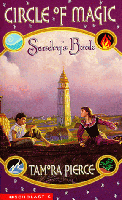The Circle of Magic Series

Pierce, Tamora. The “Circle of Magic” series (Sandry’s Book, Tris’s Book, Daja’s Book, Briar’s Book). New York: Scholastic (hc), Point (pb), 1997-2000.

(This review originally appeared in Mythprint 37:6 (#217) in June 2000.)
Reviewed by Grace Funk
Although each book in Pierce’s series centers on one of four young mages who are brought together to be educated, all four of them are equally involved in combatting evil and finding their individual talents. In the beginning, coming from very different backgrounds, none of the four fit in anywhere, because their talents are unrecognized and uncontrolled. Initially hostile, they eventually become part of one group. Each is attached to a suitable senior mage.
Sandry is an aristocrat, with the talent of spinning and weaving. At the climax of her book, she must weave together their different magics to save their city and themselves from a magic-enhanced earthquake. Tris is of a merchant family, with the talent of controlling weather and water. Her talent is able to save the city when a rogue mage invents gunpowder and uses pirates in an attempt to seize it. Again, all four of the young mages work together. Their magics are quite unlike the conventional magic of their time. Daja has a smith’s talent, Briar a gardener’s talent.
I think I enjoyed Daja’s Book most of the four. The danger of forest fire comes near home, and close also is the contrast between learning everything by rules and growing by instinctive response to what is inside one. Daja’s magic is smithing, and so she controls fire. But the magics of all four young people have become mixed, as they meet one disaster after another, so Daja inadvertently makes and nearly strangles in a plant of living iron which then eats a copper bowl. Sandry has to weave them borders, to get things back under control. The author has a most ingenious imagination: the forest fire melts a glacier, which relieves a drought; Daja grows brass skin, which she can pull off and use. I have a slight quibble with thatãthe symbolism is part of the story, well enough, but where does the extra brass come from? I ask the question because the author is careful to point out that the iron plant must be fed nails; and a copper flower Daja makes grows because there is copper in the soil. I have more than a slight quibble with the illustrator of the book jacket. Daja is riding a horse saddled as no ridden horse ever was. The girth, instead of going under the horse’s chest, just behind the front legs, is painted as going around the wide part of the horse’s belly, whence it would slide off the first time the horse let out its breath. I also enjoyed the last book in the series, Briar’s Book, very much; it is a fine story with no quick fixes, magical or otherwise.
Magic is part of the characters’ lives, but it is treated like a science. It must be studied, worked at, and applied with caution after careful experiment. Also, one’s personal supply of magic is limited, and must be tended and replenished. The setting is vaguely pre-industrial, but the laboratory where a plague cure is sought has all the (magical) precautions found in a 20th-century center for disease study. Life and death issues of poverty, disease, healing, storms, and loyalties are handled from the viewpoint of the young teen-age mages, whose personal bonds are together strong enough even to go into death and return. These books are set in a world where magic is part of life. Still the young people have to learn to know themselves, and their world, and their parts in it.
